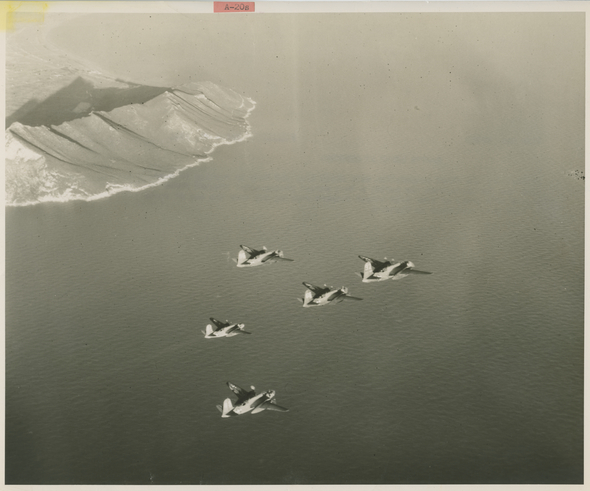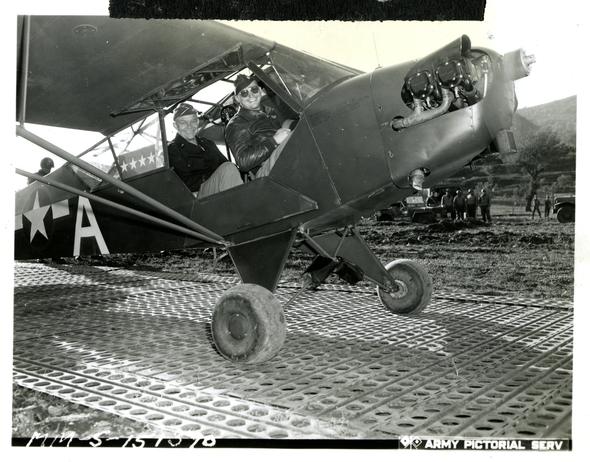COUNTDOWN TO ROAD TO BERLIN
In last week’s blog post of the Road to Berlin countdown, you learned about the story of air power in WWII in the Air War gallery. This week, let’s plunge into the content of the gallery’s exhibits: First Strikes, Losses, and Aircrews Experiences.

A group of Army A-20 Havoc attack bombers roaring out over the sea enroute to bomb Nazi positions in Cisterno, Italy in March 28, 1944. Credit: U.S. Navy Official photograph, Gift of Charles Ives, 2011.102.398
FIRST STRIKES
The First Strikes exhibit will explore the American and Allied air strategies and examine their first air attacks on European soil, discussing what was gained, lost, and learned. Bombers attempted to knock out key Axis industries – oil, aviation, military facilities, transportation, and ordnance factories – and faced fierce enemy defenses in the process. The story of the earliest missions of the Eighth Bomber Command, who earned an impressive record throughout the war and came to be known as “The Mighty Eighth,” will also be told in First Strikes. The exhibit will feature the oral histories and personal stories of United States Army Air Force (USAAF) veterans, plus various artifacts such as flight jackets decorated with signature squadron patches and elaborate artwork conveying the spirit, personalities, and experiences of American airmen. First Strikes will also examine the technology used in the air war, which made aircraft more precise and effective than ever before, as well as a replica Quonset hut – a semi-circular pre-fabricated structure that could be easily shipped and quickly constructed at bases overseas. Video footage of the air war will be projected overhead, adding another immersive element to the exhibit.
LOSSES
During World War II, the United States Army Air Force (USAAF) was up against one of the strongest and most experienced air forces in the world: the German Luftwaffe. Their fierce fighting skills resulted in high casualties among American airmen. The exhibit Losses details the Luftwaffe’s response to Allied attacks and honors the brave American airmen who risked their lives in the fight against tyranny. Artifacts in the exhibit, such as the personal belongings and uniforms of airmen, as well as the oral histories of USAAF veterans, will humanize these tragic losses. The Germans’ impressive arsenal, including weaponry such as the Flak 88 anti-aircraft artillery gun, was a major threat. The Germans also improved their aircraft, and recalled many fighters from the eastern front to join the defense against the USAAF. Americans quickly learned that they could not send bombers into German territory without being escorted by fighter planes. Improvements in fighter technology resulted in longer-range escorts, which improved the chances for Allied bombers. Various maps and photographs in the exhibit will help visitors identify these deadly weapons and will show the limits of bomber range radar compared to those of fighter escorts. American airpower had many great achievements during World War II and this exhibit will show the immense obstacles and devastating defeats they overcame on their way to victory.
AIRCREW EXPERIENCES
This exhibit will explain the treacherous flying conditions and the high risk of death in the air that the bomber crews and fighter pilots experienced during the war. Weather had a major strategic, operational, and tactical impact. Airmen were extremely exposed and vulnerable not only to hostile weather conditions but to enemy fire from both the ground and air, as the transparent nature of the air provided no natural cover in war. The fluctuating conditions of weather, environment, and enemy engagements brought great psychological uncertainties for the air crews tasked with winning the skies from the Luftwaffe. Air crews in WWII experienced hostile environments and conditions of warfare in the high altitudes which had never before been experienced in military history. The enormous industrial effort to turn out massive fleets of planes, the rigorous training and unprecedented combat experiences of pilots and crews, and the pivotal role of air power in military strategy all underline the importance of the air war for ultimate Allied victory. The deadly nature of the air war highlights the tremendous dedication, skills, determination and courage of our Air Forces, and validates why these men should never be forgotten.

General Eisenhower and a pilot in Italy on December 27, 1943. Credit: U.S. Army Signal Corps photograph, Gift of Regan Forrester, 2002.337.089
Post by Lauren Bevis, Donor Relations Manager, and Ashley Nash, Prospect Coordinator.
- Posted :
- Post Category :
- Tags : Tags: Road to Berlin Countdown
- Follow responses to this entry through the RSS 2.0 feed. You can skip to the end and leave a response. Pinging is currently not allowed.




Leave a Reply